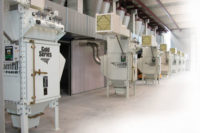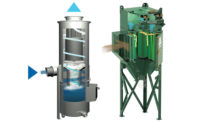EPA sets new standard for metal fabricating hazardous emissions

For many years, companies in cold or hot climates have installed cartridge dust collectors designed to remove welding fumes and recirculate heated or cooled filtered air back through the workspace. But in temperate regions where manufacturing areas are not climate-controlled, many plants have found it more expedient to exhaust weld fumes outside.
A new EPA regulation about to take effect will change all that. The regulation addresses Metal Fabrication Hazardous Air Pollutants (MFHAP) and is titled “National Emission Standards for Hazardous Air Pollutants: Area Source Standards for Nine Metal Fabrication and Finishing Source Categories”. (View the regulation at http://www.epa.gov/ttn/atw/area/fr23jy08.pdf.)
The regulation encompasses all manufacturing processes using materials that contain 0.1 percent of cadmium, lead, nickel or chromium and any material that contains one percent manganese. Most welding rod and wire has more than one percent manganese, so nearly every welding application falls under this regulation. Other manufacturing processes identified include dry abrasive blasting, machining, dry grinding and polishing, Simply put, there can be no visible emissions (zero opacity) from these types of manufacturing processes. Plants currently exhausting contaminated air outside from these processes will no longer be allowed to do so. Here are the most important steps EHS professionals should follow in approaching this challenge:
1 - ” Determine if you are impacted
New facilities built after July 23, 2008, are required to submit notification of compliance within 120 days after startup. Existing facilities must comply by July 25, 2011, and must submit notification of compliance before November 22, 2011. If you have not begun the planning process yet, there is no time to lose.
2 - ” Determine a game plan now
New facilities built after July 23, 2008, are required to submit notification of compliance within 120 days after startup. Existing facilities must comply by July 25, 2011, and must submit notification of compliance before November 22, 2011. If you have not begun the planning process yet, there is no time to lose.
3 - ” Understand the difference between EPA method 9 and method 22
The primary test methods stated in the regulation are EPA methods 9 and 22. Simply stated, if you use method 9 to judge opacity, the facility must be re-certified every six months, a process that will involve time-consuming paperwork. Under method 22, if you install a control device such as a dust collector and are able to show over an initial monitoring period that it eliminates visible emissions (i.e., achieves zero opacity), you will eliminate the need for constant re-certification.
If you elect to do nothing, you will be required by law to monitor and record emissions on a daily basis. Unless you can prove zero opacity, which may be difficult to achieve without a control device, the EPA will eventually require corrective action. If emission levels remain high, there is a potential for more drastic action such as fines or production shutdowns.
4 - ” Find a knowledgeable equipment supplier
Cartridge dust collection is identified in the regulation as an acceptable control device to eliminate visible emissions, and will in many cases be the solution of choice. Cartridge collectors offer high efficiency capture of welding fumes and particulate contaminants; and they use self-cleaning mechanisms that pulse dirt off the filters, allowing units to run for extended periods between filter change-outs. Static throwaway filters are an alternative, but they are not cleanable and therefore have to be changed frequently, resulting in higher maintenance and disposal costs as well as increased landfill use.
A well-designed cartridge dust collector will allow you to comply both with the new MFHAP requirement and with OSHA permissible exposure limits (PEL), which are also quite stringent for many metallic contaminants including cadmium, chromium and lead.
In looking for a reliable equipment supplier, ask about their experience with similar applications. Do they speak knowledgeably about how to address the latest EPA and OSHA regulations? Can they provide evidence of related application experience such as customer references, testimonials and job photos? Do they practice green manufacturing techniques in producing the equipment?
5 - ” Ask for a written guarantee of emissions
The EPA and OSHA want to know that emissions will be at or below required thresholds. Ask the filtration manufacturer for a written guarantee of emissions performance stated as grains per cubic foot. A reliable supplier should be willing to provide this, along with a warranty on expected cartridge filter life.
6 - ” Review total cost of ownership
A total cost of ownership (TCO) calculation is a step-by-step evaluation that explores energy use, maintenance, filter replacement cycles, disposal costs and more, to determine the equipment’s life-cycle cost and help you make a smart, effective and sustainable purchasing decision.
Looking for a reprint of this article?
From high-res PDFs to custom plaques, order your copy today!




